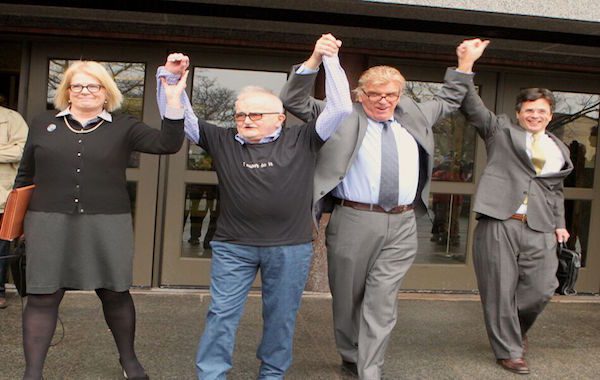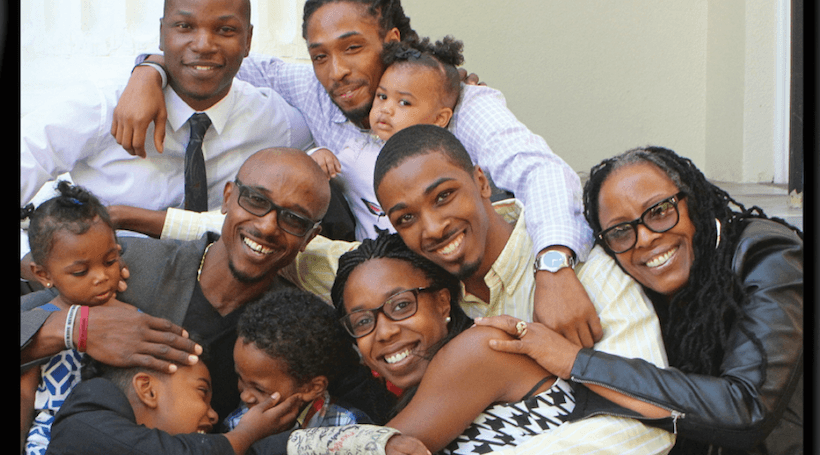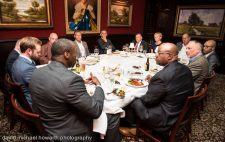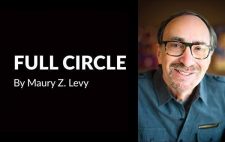Mark Schand was in prison for 27 years, and then he was found innocent.
His wife visited him in prison every Tuesday, sometimes bringing along their three sons or Schand’s mother.
For 27 years.
When he was 23, Schand was sentenced to life without the possibility of parole for the murder of a young woman police say was an innocent bystander in a drug robbery. He was convicted on the testimony of six eyewitnesses, all career criminals. But all through the trial, Schand maintained his innocence. And he was telling the truth.

Jim McCloskey celebrates with Mark Schand on the day of his release.
In 2013, Schand, then 50, was released from jail after the nonprofit group Centurion took on his case and completed a new investigation. They found additional men who were at the shooting and testified that Schand hadn’t been there. Three of the eyewitnesses from the original trial recanted. The investigators also discovered that Schand had undergone a dental procedure that day that would have kept him in severe pain for days. And, they found alibi witnesses who placed him 30 miles from the crime.
For Centurion staff, this is all in a day’s work. The nonprofit has freed 54 men and women serving life or death sentences.
“We’ve been able to give 54 people their lives back,” says Kate Germond, Centurion’s executive director. “It’s justice in a system where people aren’t always thinking about justice anymore.”
Centurion started in 1980, when a young theology student, Jim McCloskey, began his field education work at Trenton State Prison.
“My job as a student chaplain was to go to two cell blocks and become the men’s friend,” McCloskey says. “I had no experience with the criminal justice system. It was completely foreign to me.”
McCloskey began working with inmate Jorge De Los Santos, nicknamed Chiefy. “He and I just clicked. I grew to really like him,” says McCloskey, now 75. “Over time, I came to believe he was innocent.”
At the time, De Los Santos – previously a heroin addict – was sober and intelligent, McCloskey says. He would constantly talk about his case, the characters in it and his innocence.
“One thing that really struck me was what he told me about his trial in 1975,” McCloskey explains. “When the prosecutor was showing the jury photos of the victim, Chiefy said to me, ‘I was screaming internally for that man to get up and tell the truth – that I did not kill him.’”
When McCloskey got a hold of De Los Santos’ trial transcripts, poring over them during his Thanksgiving holiday, he felt compelled to do something. “He challenged me,” McCloskey says. “Basically, he said in a firm but respectful way, ‘You can’t just go back to the seminary and pray for me. That won’t do any good. I need help. I need human hands.’”
McCloskey decided he was right. He took a year off school to devote himself to working on De Los Santos’ behalf. It was a bold, unexpected move, but McCloskey felt compelled by his growing friendship with De Los Santos and the man’s professions of innocence.
De Los Santos was re-tried and found innocent. He had been convicted primarily on the testimony of a man who had given jailhouse confessions more than once, using lies to get time off his own sentence. McCloskey says freeing De Los Santos made him feel more alive – and perhaps even closer to God – than ever before.
More importantly, it allowed him to meet Paul Casteleiro, a lawyer in Hoboken who helped him free De Los Santos. In their research on the case, McCloskey and Casteleiro came to believe there were three other innocent New Jersey men enduring life sentences. But by that time, McCloskey had returned to school and completed his degree, so he had a decision to make.
“I could get ordained and be a church pastor, which is the reason I was in that prison,” he says. “Or, I asked myself, was God calling me to do something very different? Should I work to free people who I believe were innocent?”
He chose to free people. He asked Casteleiro – then a young lawyer – to assist him on cases, and the pair got to work. He founded Centurion Ministries, naming the organization after the centurion, or Roman soldier, who is recorded in the Gospel of Luke as standing at the foot of the cross.
“He looked up at the crucified Christ and said, ‘Surely this one was innocent,’” McCloskey says.
And it turned out, the three other prisoners McCloskey and Casteleiro had discovered were also innocent – and all convicted on contrived tales of jailhouse confessions. It further ignited the fire inside the two men.
“The cases were really good,” Casteleiro says. “Working with Centurion felt like I was doing what I actually went to law school for. I was a child of the ’60s, and we were about justice and affecting changes, and that’s what motivated me to be a lawyer in the first place. Centurion fulfilled my expectations in life. I felt like I was actually doing justice.”

Kate Germond and Paul Casteleiro with Richard Lapointe (center) at his release after 26 years in prison.
Centurion has developed from a one-man team to a group of 15 staff members and 25 volunteers. The organization routinely receives about 1,500 new requests every year and can be working on more than 150 cases at any given time.
It all starts with a letter from an incarcerated individual claiming their innocence. A staff member writes back with a detailed questionnaire about the crime, the case, the trial and who the individual is. Once it’s returned, the staff member will decide if the individual’s case fits their criteria and then assesses whether the case is “red hot” or if it can be filed into the regular queue.
The criteria are simple – well, sort of.
“You have to be absolutely innocent,” Germond says. “Meaning you had nothing to do with the crime. You didn’t loan the car, you weren’t in the place where the crime happened in any other capacity than a mistake.”
If the criteria are met, Centurion starts investigating. They want to understand the person asking for help, to be sure if they’re released, they can lead a productive life. They examine every single detail of the crime – conducting field investigations and re-interviewing witnesses, often showing up at their homes with no warning. Because of the deeply detailed work, field investigations take time. Their funding comes from private donations.
“We just finished one case that was 12 years before we even got to court,” Germond says. “It takes an incredibly long time, and we’re fought all along the way. Even in the most clear-cut cases, the prosecutors will figure out a way to fight us. But you must keep getting out of bed and fighting, or somebody stays in prison. We’ve made a commitment to them.”
Often, those commitments don’t just change lives – they change the justice system. Take the case of Clarence Moore, an Atlantic City man. He was convicted of a 1986 rape where the victim repeatedly admitted she did not see her assailant clearly. After undergoing hypnosis to refresh her memory, she identified Moore as her assailant.
“It was unbelievable he was convicted on that,” Germond says. “But we were able to debunk the whole hypnotically-refreshed testimony idea.”
Thanks to Centurion, Moore was not only freed in 2001, but hypnotically refreshed testimonies are no longer admissible in state courts. Today, Moore – though he eschews public attention, particularly from the media – works for a nonprofit serving needy families throughout the state.
“A lot of things contribute to false convictions,” Casteleiro says. “Misconduct by police and prosecutors, bad lawyering, bad science, jurors that are predisposed to convict, racial discrimination. Sometimes it’s subtle and sometimes it’s not so subtle. Sometimes when you’re reading the transcript, you’re bewildered the guy even got convicted.”
Seeing exonerated men and women succeed after being freed is also part of Centurion’s work, Germond says. “That’s one of the things that distinguishes us from similar projects,” she says. “We do count these guys as family, and we stick with them all the way through.”
But sometimes, despite years of work, an innocent person doesn’t get to come home.
“That’s the worst,” Germond says. “Cases where we absolutely believe someone’s innocent but the case has been so worked over we don’t see what we could do to help them. And we have to send them away, even though we’re pretty sure they’re innocent.”
The staff at Centurion is more likely to lose sleep over those they can’t free than those they have. If even one staff member disagrees about a person’s innocence, the case gets pushed back to the previous step until that staff member is convinced. If they’re not, the case is dropped. And Germond says they haven’t been afraid to walk away from cases.
But still, “you don’t ever know with 100-percent certainty that someone’s innocent,” Casteleiro says. “You look at a case, you investigate and you make an intelligent decision. That’s all you can do.”
Making those judgments and fighting those fights, however, has brought an extraordinary amount of meaning to all three of their lives. “Sometimes, I think back and say, ‘I could’ve made a lot more money,’ but I feel pretty good on the whole about how it’s turned out,” Casteleiro says with a smile. “It’s given me a lot, I think.”
“I feel very lucky to have stumbled into what turned out to be my calling in life,” McCloskey adds. “I still believe God opened that prison door. Without that first man, that Newark heroin addict, there wouldn’t be any Centurion Ministries.”
Today, a freed Mark Schand lives in Connecticut and works in the local Colt gun factory. He hopes to create a nonprofit that helps parolees better their lives.
“These guys we’ve freed,” says Germond, “the reality is, they’re better humans than most of us. Whatever lessons they took away from their wrongful incarceration, it wasn’t bitterness or anger or getting retribution. What they took away was things that were the opposite of their experience – forgiveness, acceptance and love. So much love.”














